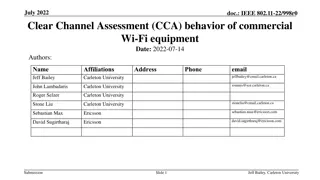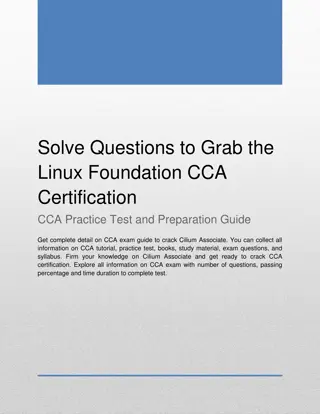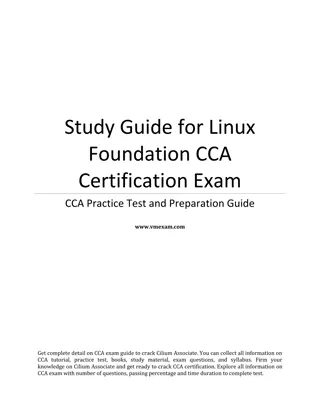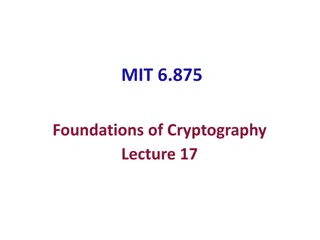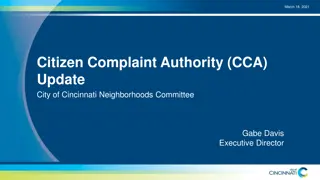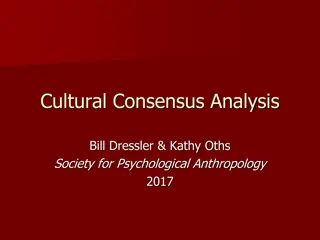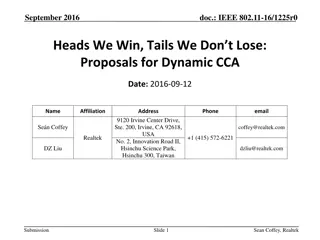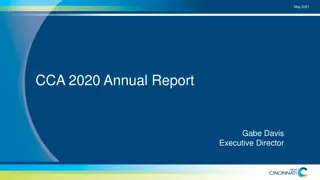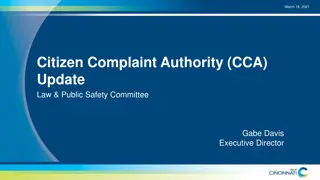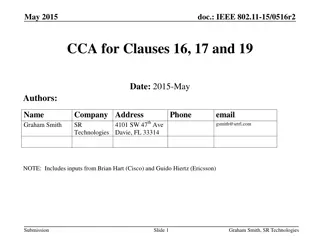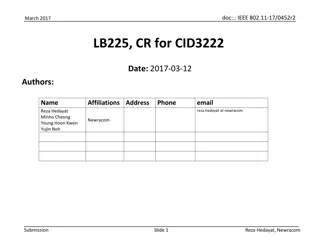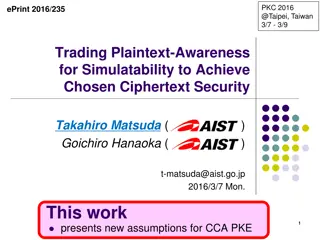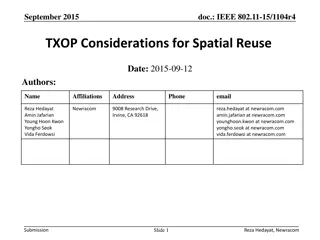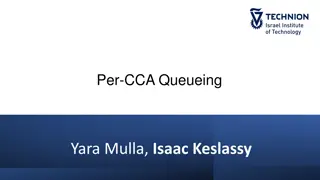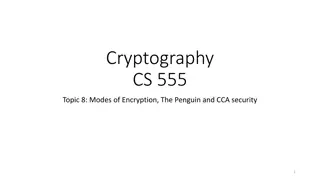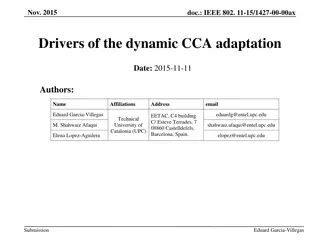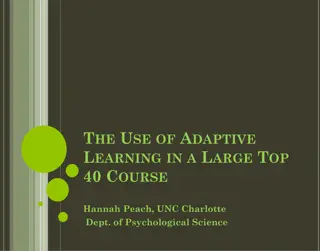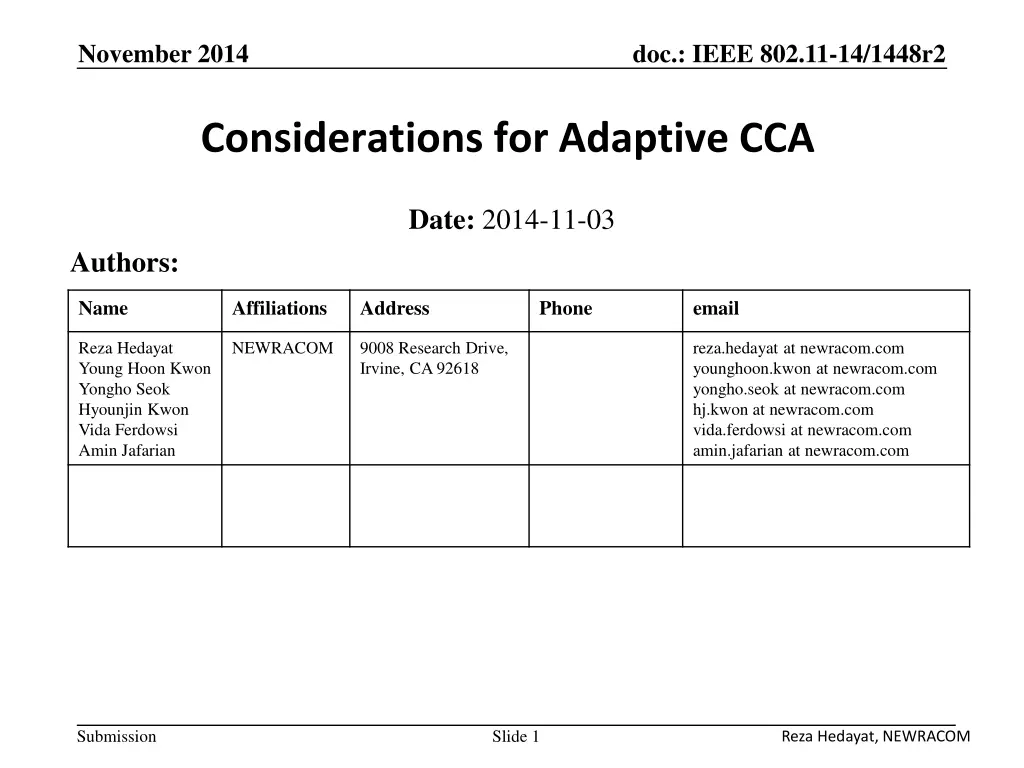
Adaptive CCA Role in WiFi Deployments
Explore the considerations for adaptive CCA in IEEE 802.11-14/1448r2, focusing on its role in various WiFi deployment scenarios such as residential, office, and public areas like airports and malls. The discussion highlights the need for adaptive CCA algorithms to address challenges posed by multiple managed WLANs with significant cross-coverage, emphasizing the importance of effective frequency planning and power control for enhanced medium efficiency in wireless communications.
Download Presentation

Please find below an Image/Link to download the presentation.
The content on the website is provided AS IS for your information and personal use only. It may not be sold, licensed, or shared on other websites without obtaining consent from the author. If you encounter any issues during the download, it is possible that the publisher has removed the file from their server.
You are allowed to download the files provided on this website for personal or commercial use, subject to the condition that they are used lawfully. All files are the property of their respective owners.
The content on the website is provided AS IS for your information and personal use only. It may not be sold, licensed, or shared on other websites without obtaining consent from the author.
E N D
Presentation Transcript
November 2014 doc.: IEEE 802.11-14/1448r2 Considerations for Adaptive CCA Date: 2014-11-03 Authors: Name Affiliations Address Phone email Reza Hedayat Young Hoon Kwon Yongho Seok Hyounjin Kwon Vida Ferdowsi Amin Jafarian NEWRACOM 9008 Research Drive, Irvine, CA 92618 reza.hedayat at newracom.com younghoon.kwon at newracom.com yongho.seok at newracom.com hj.kwon at newracom.com vida.ferdowsi at newracom.com amin.jafarian at newracom.com Submission Slide 1 Reza Hedayat, NEWRACOM
November 2014 doc.: IEEE 802.11-14/1448r2 Adaptive CCA Role in WiFi Deployments In past meetings, many suggested some form of adaptive CCA rule would allow for enhanced medium efficiency Most of the simulated scenarios for adaptive CCA consider residential scenario where BSS s have minimum cross-coverage. This allows some proposals to offer gain, where the same proposal could significantly increase collision in scenarios where co-channel BSS s have cross-coverage Example of WLAN deployment in an apartment complex, or wireless office. Each circle shows coverage area of an AP. The color does not represent frequency planning. Submission Slide 2
November 2014 doc.: IEEE 802.11-14/1448r2 Adaptive CCA Role in WiFi Deployments But distinction between the 11ax scenarios could get blurry when: Multiple managed networks operate in the same location (e.g. scenarios 3 and 4), where the cross-coverage of APs is maximum Increasing number of P2P activities (which reduces frequency reuse) For instance, Scenario 3 is indoor/outdoor hot-spot managed deployment, where it is expected that it has well-designed frequency planning and power control among managed APs However, in many WLAN deployments frequency planning is far from perfect and APs cross-coverage is large Example of WLAN deployment by independent vendors in an airport terminal. Each circle shows coverage area of an AP. The color does not represent frequency planning. Submission Slide 3
November 2014 doc.: IEEE 802.11-14/1448r2 Adaptive CCA Role in WiFi Deployments In such environments (shopping malls, airports, sport arenas etc) it is likely that there are multiple managed WLANs each operated by an operator, where the frequency planning and power control of each WLAN is done independently from others Overall, in almost all places, there is no way to restrict individuals to operate autonomous APs in managed-WLAN area Such collocated multiple managed WLANs is not well-considered in 11ax simulation scenarios Since we expect an 11ax-enabeled STA to work well in all scenarios, we suggest to design adaptive CCA algorithms to consider the most general case of presence of multiple BSS/OBSS with large cross-coverage Submission Slide 4
November 2014 doc.: IEEE 802.11-14/1448r2 Adaptive CCA An immediate consequence of adaptive CCA is additional hidden nodes. All the classical problems (solutions) with hidden nodes apply to the newly introduced hidden nodes. In this figure, STA0 wants to adopt adaptive CCA rules. By doing so, a large percentage of STAs in its -82dBm neighborhood become hidden to STA0 STAs that become hidden due to CCA>-82dBm Hidden STAs for CCA=-82dBm However, depending on the destination of the frames sent by the new hidden nodes, STA0 s frame may or may not collide with ongoing frames STA0 CCA > -82dBm CCA=-82dBm Submission Slide 5
November 2014 doc.: IEEE 802.11-14/1448r2 Adaptive CCA and Neighborhood Awareness An adaptive-CCA STA should know about its neighborhood to avoid corrupting ongoing frames whose recipient might be within its coverage For instance, assume STA0 wants to send a frame to STA8. The medium is busy due to frame sent by STA3 to STA4. If STA0 adopts a CCA>-82dBm, ongoing frame is ignored, STA0 s frame that collides with it 3 3 CCA=-82dBm 4 7 CCA > -82dBm 11 1 STA0 9 10 6 5 8 4 7 2 Another instance is the case where STA5 sends a frame to STA11, and If STA0 adopts a CCA>-82dBm, STA0 might ignore the ongoing frame, and yet affects reception of STA11 insignificantly 11 1 STA0 9 10 6 5 8 2 Submission Slide 6
November 2014 doc.: IEEE 802.11-14/1448r2 Current CCA Rule in 802.11 Current CCA rule in 802.11 is based on the energy received from the transmitter of a frame, irrespective of the frame s recipient For instance, in below figure, when STA0 sends a frame, CCA at STA1 turns busy irrespective of the destination of the frame sent It is fair that STA1 s CCA turns busy when STA0 sends frames to STA4. But it is not necessary that STA1 s CCA turn busy when STA0 sends frames to STA3 This means, with respect to STA0 s transmission, STA1 s CCA should become busy only when the recipient of STA0 s frame is within the cross- coverage area (shown in yellow) STA3 STA4 STA0 STA1 CCA=-82dBm CCA=-82dBm Submission Slide 7
November 2014 doc.: IEEE 802.11-14/1448r2 Neighborhood-aware Adaptive CCA Consider that each STA acquires some transmitter/receiver IDs of every frame that it captures In next slides it is explained how to obtain such identification By gradually collecting the list of transmitters and receivers in its -82dBm neighborhood, a STA would realize, when a nearby STA sends a frame, whether the recipient STA is nearby or not A possible rule for adaptive CCA is: If the recipient STA is not in its -82dBm-neghiborhood, the STA can adapt CCA>- 82dBm toward the ongoing frame (and likely prepare to transmits its own frame) If the recipient STA is in its -82dBm-neghiborhood, the STA may not adapt to CCA>- 82dBm and respect the -82dBm CCA rule Submission Slide 8
November 2014 doc.: IEEE 802.11-14/1448r2 Neighborhood-aware Adaptive CCA Each STA is allowed to adapt CCA if it has gathered history of frame exchanges in its neighborhood for a minimum duration, so that it forms a reliable neighbor list Hence, power-save STAs are allowed to use adaptive CCA only when they have observed the channel long enough, e.g. their total awake time reaches the minimum duration required so that the collected list of the neighbors is reliable and stable Mobility situations can be handled by keeping the neighborhood list updated when (a) neighboring STAs don t appear as transmitting STA after a TBD duration, and (b) new STAs appear as transmitting STA Note that mobility of STAs happens in order of seconds (human speed), while it d take in order of sub-second to identify that a STA is in the neighborhood and place it to the neighbor list Submission Slide 9
November 2014 doc.: IEEE 802.11-14/1448r2 Complexity of Neighborhood-aware Adaptive CCA Decoding the MAC header, it is possible that each STA obtains the RA/TA of every frame the STA captures, and form the list of its neighbors But MAC header decoding of all the captured frames increases power consumption To avoid increased power consumption, one solution is to carry some transmitter/receiver identification in the SIG symbols Receiver indication is already done in 11ac SIG-A using PBSSID/PAID However there is no transmitter identification (TXID) in 11ac SIG symbols. Such indication can be added to one of 11ax SIG symbols 802.11ah has added AP/BSS identification, Color field, in DL frames The number bits to be assigned to TXID deserves a separate discussion Due to shorter identification compared to MAC address or associations ID, there is a chance for PAID/TXID collision. While such collisions are not catastrophic, their effect should be studied Submission Slide 10
November 2014 doc.: IEEE 802.11-14/1448r2 Complexity of Neighborhood-aware Adaptive CCA To evaluate complexity of constructing the list of neighbors, consider that for a reference STA, e.g. STA0: There are N STAs within its -82dBm coverage, and There are M STAs within the coverage of these N STAs but not in the coverage of STA0. These are the STAs that don t appear as a transmitting STA to STA0, but appear as a receiving STA STA0 keeps a list of size N for all the STAs within its coverage Some additional info such as whether a given STA has sent any frame in the past TBD time interval may be kept STA0 need not keep a list of above-mentioned M STAs. Even if one of those STAs move to the coverage area of STA0, it makes its way to the list of neighbors Submission Slide 11
November 2014 doc.: IEEE 802.11-14/1448r2 Adaptive CCA and Legacy STAs While reading the SIG field of the frames from neighboring STAs, each STA would arrive to the conclusion that what percentage of the STAs around are legacy devices For sake of fairness toward legacy devices, a STA might stick to CCA=-82dBm if there are more legacy STAs than a TBD threshold Also, in order to gain more from adaptive CCA, an alternative is that STAs optionally read MAC headers of the legacy frames, read the RA/TA fields and process them with the same principle Submission Slide 12
November 2014 doc.: IEEE 802.11-14/1448r2 Conclusion The basic principle of this proposal is that each STA gradually gathers the information that identifies its neighborhood After the status of the neighborhood list reaches some confidence, the STA applies adaptive CCA approach: whenever a new frame is captured, given the neighborhood list, the STA adaptively changes its CCA if the frame is not destined to any of the STAs in the neighborhood Such processing can be done with no additional power consumption if some transmitter identifications are carried in 11ax SIG symbols This approach could deal with large presence of legacy STAs to keep it fair to legacy devices Submission Slide 13

